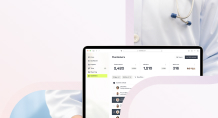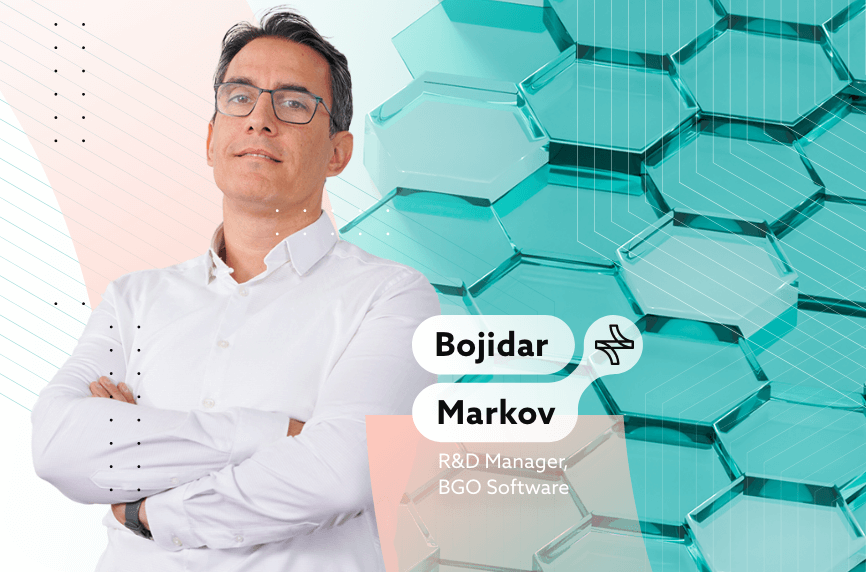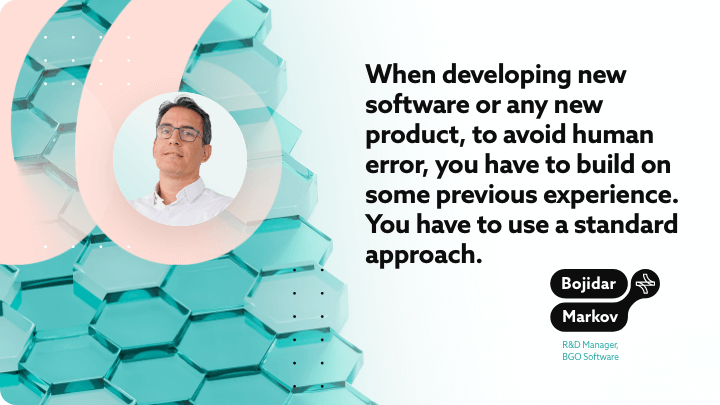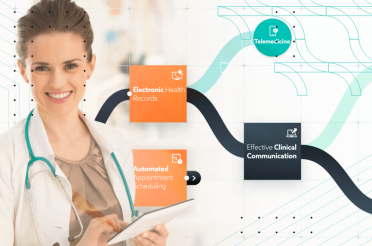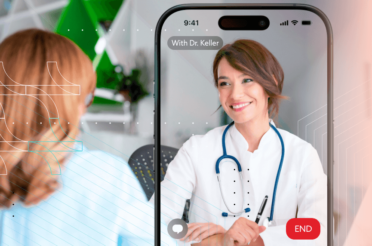The process of merging data from several sources inside the healthcare system into a single, comprehensive format is known as healthcare data integration. This process facilitates improved decision-making, enhances patient care, and streamlines operations by giving healthcare providers a thorough perspective of patient data.
With Bozhidar Markov’s assistance – R & D Manager at BGO Software – in this article, we will examine the significance of these processes, their applications, and some best practices for their efficient execution.
Types of healthcare data integrations
Medical data integrations fall into several major categories, each of which serves a distinct set of requirements and systems in the healthcare setting:
- Electronic Healthcare Records (EHR);
- Study data;
- Clinical trial data;
- Lab results, and others.
“It depends on what kind of application programming interfaces are being written, what they are for, and what type of data is required. There is rarely an app that works with every type of healthcare data integration.”
Electronic healthcare records are not specific to patients only. Of course, healthcare applications focus on patients, but not all health data is directly related to them. Some help medical experts form and produce more minor characterizations of disease manifestation and patient behavior.
“In a typical clinical research, there is an enormous amount of information about medications, processes, procedures, documentation, irrelevant to such a large number of patients.”
To have a better grasp of the subject, we could give an example of software designed for ethics commissions. Here, the emphasis is on following norms and ethical requirements, with particular attention paid to limits that are unrelated to a specific customer. The topic of discussion is the clinical study itself.
Importance of data integration in healthcare
Healthcare software development companies make software for various clinical purposes and provide it to hospitals and various healthcare providers. The ultimate goal is for healthcare facilities to operate and benefit patients, allowing them to monitor their health and clinical pathways.
Such software projects also assist health experts and medical professionals in data collection and systematization about the people they treat.
Here is a practical example of why integrating healthcare data is important:
- A patient participating in a clinical study is examined to record results at a clinic or the medical office where he has declared his participation. A medical person records his data in a health system – a particular software providing data on the patient, the procedures, the medications, the patient’s indicators after treatment, etc. It still depends on the function and purpose of the clinical trial. As in most cases, the patient can check his data on the Internet through an application or a page on a website connected to the clinic’s system.
- In other cases, the patient reports his condition and manifested symptoms using a particular application that records his data, reaching the doctors through the systems.
- However, the patient has little access to the information such applications collect. This is not done for harm and unlawful collection of information but rather to simplify the data to be adequate for non-medical persons. The remaining information stored for accurate analysis, improvement, and development of new medical devices is helpful to clinical specialists for management and process improvement.
- Monitoring is established on the doctors, whether they follow specific procedures when taking data or treating patients. Other considerations are whether doctors regularly schedule patients for check-ups and consultations, ensuring consistent monitoring and follow-up care. Whether the medical facility and doctor’s office are well-maintained, equipped with the necessary tools and resources for quality patient care. They ensure that the doctor’s healthcare system is adequate and up-to-date, enabling efficient patient information management.
- Additionally, it checks if the doctor is fully competent and proficient in using the system, ensuring smooth and effective operations during patient interactions. This is another way to feed data to the system.
Regarding the large amount of information that needs to be processed, Bojidar expressed the opinion:
“Given the diversity of these data sources, it is not necessary for them all to be consolidated in one place; the purpose of the software that is being created will ultimately determine this.”
For instance, if it is intended for patients, a small amount is taken and delivered to them in a reduced and intelligible form. With his experience in this field, Markov explained that if we are talking about clinical trial management software, other parts of the data are taken there.
In such software, for example, patient data is not provided under any circumstances. In this more abstract stage, the data is anonymized, and the administrators of these programs are not allowed to access the personal data of any patient.
Choose the right integration software for your company Speak to an expert today, and see how our on-demand IT talent and augmented teams can efficiently deliver value at every step of your roadmap.

What if there was no data integration?
Without Clinical Data Integration and interoperability, physicians, facility managers, and other healthcare workers would have ten different systems performing different functions and entering their patients’ different data separately into each one.
According to the BGO expert, many different pieces of software can lead to confusion, human error on the part of doctors and patients in data sharing, and incorrect results.
“The goal of integration is to save time and reduce errors when transferring information between systems. Often, you need data from two others to do your job well in one software of this nature. Data integration is done to avoid viewing big data information in Excel tables and copying and moving it.”
Automated data integration is also helpful because it allows for easy localization and quick response and notification in case of a discrepancy in metrics or a lack of data.
Suppose a patient has an electronic healthcare record. In that case, he will not have to carry tests from past procedures on paper when visiting a doctor or if he wants a second opinion from another specialist in another hospital.
The system should automatically provide the patient’s medical history and interventions in the various health facilities in digital data formats when the doctor types the name or other keyword or ID on the computer. For all this to be possible, data integration strategies are necessary, and it has to be possible for the different hospitals and departments to communicate, transfer, and integrate data.
Another more common option abroad is to have a centralized hub that collects the information from all medical providers for a particular patient from the system on request and displays all the clinical information and where it is collected.
Main healthcare data integration challenges
A centralized healthcare system allowing digital access to all clinical information from different clinical and hospital facilities of each patient sounds like a beautiful solution. It addresses the problem of paper medical documents that doctors have to describe and store most of the time on paper and patients to carry whenever necessary to go to the doctor.
However, what are the difficulties in building such software applications?
As a programmer with experience in the field, according to Bojidar Markov, one of the more severe problems is standardization.
In the creation of software systems, one of the things in which standardization is expressed is the choice and agreement to work according to a specific protocol to avoid problems and misinterpretations. A protocol is the way data is structured and transmitted.
The BGO expert further added that:
“A programmer with little experience can also develop a corresponding protocol to set the data structure. Still, due to his misunderstanding, he might fail to request important data that the system analysts would later need to compile comprehensive reports of large groups of patients.”
Suppose we create such a system with a new original protocol that requires the patient to enter what medicine he took and when. The system is put into use, and after a while, the analysts want to calculate and report how many milligrams of medicine a given number of patients has taken.
However, in our software, we have no position to store quantity, and it turns out that we cannot provide information about the milligrams taken by the patients.
In Markovs’ opinion:
“Standards provide a framework for how information is required, structured, and presented.”
One of the other serious security challenges for developers is the prevention of data leaks and data privacy regulations. There are different types of security threats. One of them is the malicious party that physically inserts a virus into a computer containing medical data, usually through a flash drive, with the intention of spying.
Information traffic is monitored, and all of the opened applications can be seen. The protection against this kind of attack is the encryption of the data exchange between the server and client; the server transmits encrypted messages so that even a third party with access to the data transfer but without the encryption key cannot decipher the correspondence.
Other possible risks are:
- Exceeding the specified budget;
- Not meeting the estimated time due to changes in the logic or the hardware or due to new functionalities added;
- Risks of damaging the system due to brute force testing.
Cybersecurity companies are hired to check how reliable the new systems are. Penetration tests are applied prophylactically once or twice a year. Their purpose is to find loopholes in the code. This allows the programmers who created the system to see which part of the system is vulnerable and fix the problem.
Sometimes, more malicious tests called Brute Force tests are applied. That can lead to a complete system crash and sometimes to hardware malfunction. This can additionally make the construction of the project more expensive.
Best practices for healthcare data integration and interoperability
When developing software, it is a good practice to consider the application’s overall idea and the path to reach a finished version. Making a clear plan before giving the task to the programmers is always recommended.
What can make a software project more expensive is changes in logic at the stage of code creation. This is why some healthcare companies hire business analysts and resort to consulting services of computer architects and computer engineers to build the idea and the client’s path (User Journey) through the app.
For specific projects such as healthcare software or clinical research systems, it is also necessary to ask medical personnel for their opinions on building a prototype-based version of the mock system, allowing doctors to judge whether it is convenient. Once all these stages have been passed and described in well-structured documentation, the task can be handed over to the programmers.
After the completion of the project, the finished system is provided to the guarantor company for tests and an acceptance process. It is determined whether there is a need for corrections, and if everything is successful, it is put into operation. It may seem like a long and cumbersome process, but in this way, companies save time and money, and the work process of each group runs more smoothly.
As per R&D manager Markov, the business analyst is critically important, and very often the relationship between health care providers and developers. Analysts can help clients arrive at a clear vision that satisfies their desires while simultaneously presenting all this information in an appropriate way to programmers.
Deliver a world-class Healthcare project–with high-skilled, seamlessly integrated IT talent Learn how from our consultants. We work with clients worldwide.
Data integrity verification
The software needs to have Data Integrity Verification. An example here we can give is the data entered by the end user. Data Integrity Verification checks if the data is in the correct format. On the other hand, there is also a subsequent verification check at a higher level. The system can perform various types of calculations on the data entered by the user, compare two data fields, and many other things before issuing a validation.
To clarify the picture, we will give an example with two age fields in a healthcare system: a blank field for entering numbers and a Date Picker. The first basic check when entering data is that the data type matches the type the system’s policy is set to receive. If the type matches, it goes to the next check, making sure whether the data from the number field matches the data the user selected in the Date Picker.
After this check also passes, many more similar ones can be made as the complexity of the check increases. If we continue with the example, we can imagine how the system already with validated data sends it to another one with access to several other information resources about the specified user to which the first system does not have access. If a check is made there and there is a discrepancy in the data, an error can be given in the first system.
Exception handling
These errors or inconsistencies can be solved in different ways, again depending on the logic and design of the system.
An error can be returned with a reason message to the end user, which can be flagged and forwarded to an administrator for review and resolution if the error is larger or complex or requires a higher level of access.
Ensuring data security and compliance
As we mentioned before, when such software is affected in clinical studies, the patient’s individuality and personal data are entirely excluded. However, we are still discussing vast amounts of patient data collected from different places. This raises questions about the security and protection of patient data.
Electronic medical records, which personal doctors use, must hold our data. There, the data is not anonymized, but protection is still necessary through the encryption of the data. This approach ensures that if a hacker can get into the centralized storage database and download data from there, the encrypted data cannot be helpful because it can only work at the source.
User access controls
A more straightforward way to ensure protection is by entering password tokens and setting roles – admin, user, rights, and access levels that limit end-user rights. A GP should only be able to access information about his patients without being able to access other patients in different hospitals.
Control in healthcare data systems involves authentication, which verifies the identity of the medical personnel, and authorization, which ensures that the identified person has the appropriate access rights to specific resources.
Regulatory compliance in medical data integration
Healthcare Data Integration services greatly aid in regulatory compliance and monitoring as they systematize information, making reporting compliance to required regulatory bodies easier.
In the healthcare field, every change in a given project has to be described and taken into account. Every researcher should have an audit trail. Without this step, the software cannot be validated and used. Audit trails help quickly trace and capture the cause of a problem in the system.
The actions of a person participating in a project can be tracked to determine if he exceeded the powers given to him, did something malicious, or accessed information that he shouldn’t have.
For medical software to be approved for use, it must satisfy both the requirements of the client in particular hospitals and healthcare facilities. Also, it needs to be able to meet the country’s specifications in the form of other types of regulations, such as the software being able to partner with different types of government systems. This has to be specified and planned in the initial stages of building the new software in its design.
Maximizing data accuracy and consistency
Data accuracy and consistency are clusters that allow the unification of data attached to custom software.
Standard protocols and packages are used, providing different functionalities and types of data structuring to support developers as much as possible by allowing ready-made, already invented practices and solutions for part of the actions.
Different types of protocols are used for authentication and authorization.
Bojidar Markov suggested that:
“It is a good practice to reuse already created solutions in the industry, such as protocols and similar functionalities from various interfaces. You can think about how you will create a better protocol than the existing ones. Still, you’re more likely to make mistakes as happened with the previous protocols, which have already cleared some of their initial problems and have been tested over time.”
The situation in the technology industry is very dynamic and changing almost constantly. While operating principles and protocols are replaced nearly every four to five years, healthcare software development has held one level of development with specific principles for much longer. This is due to the difficulty of implementation, the impact that such a change will have, and the funds that will have to be allocated.
Streamlining workflow with integration
Integrate data from different parts of the organization to improve collaboration between departments. Ensure healthcare professionals have access to combined data sets to enhance patient care and decision-making. Using unified dashboards that display patient information from various sources in one place can help clinicians save time.
“Anything can be integrated. The point is that the level of integration will be different.”
The BGO expert provided a simple example: giving some input and information to the system. Imagine taking a paper document and manually converting it into a digital format, including all its details. This is possible, but it’s a slow process and can lead to human errors. To reduce mistakes and manual work, it’s better to automate routine tasks.
Leveraging interoperability in healthcare
Interoperability means creating software that isn’t limited to a specific use. It’s a good practice to use common protocols and standards so the software can be easily replaced by other programs that also use them if necessary. The goal is to use standard communication methods, allowing for quick and seamless changes without needing to replace software.
Еffective strategies for healthcare data interoperability are:
- Using APIs to facilitate the health information exchange between systems by enabling communication can positively impact them;
- Cooperation with suppliers who ensure data interoperability is a high priority in their goods;
- Regular testing of systems for interoperability will help ensure that data can be exchanged and interpreted across multiple platforms.
It is of great benefit to the development of healthcare organizations to keep up with the latest developments in healthcare data interoperability and incorporate them into their systems.
Data mapping and transformation
In the case of integration, the two systems cannot always understand each other well enough, so data transformation is used. It happens when one system transmits information to the other.
Not all information needs to be selected and transformed for the receiving system to understand and use it effectively. It is crucial in this situation to test the data for errors and inaccuracies, and automated tests and real-time checks are necessary. Otherwise, there is a risk of introducing invalid data into the system.
Whether you’re a startup, a Fortune 100 company or a government organisation, our team can deliver a solution that works for you. BGO Software
Choosing the right integration software
Some helpful guidelines if the company decides to hire a team of developers to create a custom system are:
- Define the desired functionalities, purpose, and target audience from the outset. Consider consulting industry standards to guide your decisions.
- Clearly articulate your long-term vision for the software, including potential growth and scalability. Engaging with experts to evaluate hardware and software technologies is crucial in aligning your choices with current best practices.
- Conduct a thorough risk analysis and outline the different stages of development, forming dedicated teams for each phase. Provide teams with precise instructions and clearly defined tasks to ensure alignment with project goals.
- Explore various hosting options and prioritize system optimizations to enhance performance and user experience.
Software giants such as PHP, SAP, and Microsoft have ready-made software with general functionalities intended for the various businesses they provide to their customers. Still, of course, there are certain limitations.
However, sometimes, no matter how good such software is, it cannot perform all the functions required by the client. Therefore, the healthcare organization can either invest significant money and order custom software with all the necessary functions or continue with the ready-made software, for which the organization is charged a license fee.
All things considered, improving patient care, increasing operational effectiveness, and encouraging innovation in the healthcare sector depend heavily on effective data integration tools. Healthcare companies aim to unify data to reduce costs and improve data quality, enhance patient engagement, and support the patient’s health.
Many healthcare organizations may effectively accomplish these objectives and maintain their competitive edge in a quickly changing market by utilizing the experience and customized solutions provided by BGO Software.




